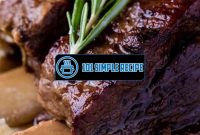️ Looking to master the art of cooking salmon in the slow cooker? Look no further! In this article, we will guide you through the process of creating perfectly tender and flavorful salmon using your trusty slow cooker. Whether you’re a seasoned home cook or just starting out, this method is foolproof and will yield impressive results every time. Plus, it’s incredibly convenient – simply set it and forget it! So, let’s dive in and discover the secrets to creating melt-in-your-mouth salmon with minimal effort.

Choosing the Right Salmon
When it comes to cooking salmon in the slow cooker, choosing the right type of salmon is crucial. The texture and flavor of the fish can vary depending on various factors. Let’s dive into the important considerations to help you make the best choice for your slow cooker recipes.
Fresh vs. Frozen Salmon
One of the primary considerations when selecting salmon is whether to go for fresh or frozen. Both options have their pros and cons, and it ultimately depends on your preferences and availability.
Fresh Salmon: Fresh salmon is known for its superior texture and taste. It has a delicate and buttery flavor that can elevate any dish. Additionally, fresh salmon tends to have a firmer flesh, making it easier to handle during the cooking process. However, the downside is that fresh salmon is not always readily available, and it can be more expensive compared to the frozen variety.
Frozen Salmon: Frozen salmon is a convenient option that offers great flexibility. It is usually flash-frozen at its peak freshness, preserving its flavors and nutrients. Frozen salmon is often more affordable and accessible. However, it’s important to thaw the fish properly before cooking to maintain its texture and prevent any loss of moisture.
Boneless or Bone-In
Another crucial decision to make is whether to choose boneless or bone-in salmon. Both options have their merits, and it primarily depends on your personal preferences and the specific recipe you plan to prepare.
Boneless Salmon: Opting for boneless salmon offers convenience and ease of eating. It saves you the trouble of dealing with bones while serving the dish. Boneless fillets are also more uniform in thickness, allowing for even cooking. They are perfect for dishes where presentation and convenience are important factors.
Bone-In Salmon: Cooking salmon with the bones intact can add extra flavor and moisture to your dish. The bones act as a natural barrier, helping the fish retain its moisture and preventing it from drying out. The bones can easily be removed once the salmon is cooked, and they can even be used to make a flavorful fish stock or broth.
Skin On or Skinless
Finally, you need to decide whether to cook your salmon with the skin on or skinless. Both methods have their advantages, and it depends on the final outcome you desire.
Skin On: Cooking salmon with the skin on can contribute to a crispy and flavorful exterior. The skin acts as a protective layer, keeping the flesh moist and enhancing the overall taste. If you enjoy the crispy texture and added flavor, leave the skin on. Just make sure to remove the skin before serving if you prefer not to eat it.
Skinless: If you prefer a more delicate and tender texture, consider removing the skin before cooking. Skinless salmon fillets are often preferred for dishes that require a milder flavor profile or for those who simply do not enjoy the taste and texture of salmon skin.
In summary, choosing the right salmon for your slow cooker recipes involves considerations such as freshness, bone-in or boneless, and skin-on or skinless. By making informed decisions based on your preferences and the specific recipe requirements, you can master the art of cooking salmon in the slow cooker.
Garlic bread sticks make a great side dish to accompany your slow cooker salmon.
Preparing the Salmon
In order to cook salmon in the slow cooker, there are several important steps that you need to follow to ensure that your fish turns out moist and flavorful. These steps include thawing the frozen salmon, deciding on seasoning options, and trimming and portioning the fish.
Thawing Frozen Salmon
If you are using frozen salmon for your slow cooker recipe, it is crucial to thaw it properly before cooking. Thawing the fish allows for even cooking and prevents the salmon from becoming dry and tough.
- One effective method for thawing frozen salmon is to place it in the refrigerator overnight. This slow thawing process ensures that the fish remains at a safe temperature and gradually defrosts.
- Another option is to use the defrost setting on your microwave. However, be cautious when using this method, as it can lead to uneven thawing and partially cooked areas of the fish.
By thawing the salmon properly, you can avoid any potential food safety hazards and ensure that your slow cooker salmon turns out perfectly.
Seasoning Options
When it comes to seasoning your slow cooker salmon, the options are endless. From simple herbs and spices to flavorful marinades, there are numerous ways to enhance the taste of your fish.
- Classic Lemon and Dill: Combine fresh lemon juice, minced garlic, and chopped dill to create a tangy and herbaceous marinade for your salmon.
- Asian-inspired Glaze: Mix together soy sauce, honey, ginger, and garlic to add a delicious Asian twist to your slow cooker salmon.
- Spicy Cajun Rub: Create a spicy and bold flavor profile by rubbing your salmon with a mixture of paprika, cayenne pepper, garlic powder, and onion powder.
Feel free to experiment with different seasonings and flavors to find your favorite combination for slow cooker salmon.
Trimming and Portioning the Salmon
Before placing the salmon in the slow cooker, it is important to trim any excess fat and portion the fish into individual servings. This ensures that the salmon cooks evenly and prevents any undercooked or overcooked areas.
Tip: Use a sharp knife to carefully remove the skin from the salmon fillet before portioning it into smaller pieces. This not only helps with even cooking but also makes it easier to serve.
| Portion Size | Approximate Cooking Time |
|---|---|
| 4-ounce fillet | 1-2 hours |
| 8-ounce fillet | 2-3 hours |
| 12-ounce fillet | 3-4 hours |
By following these portioning guidelines, you can ensure that the salmon is cooked to perfection in the slow cooker.
With these essential steps to prepare the salmon for the slow cooker, you can easily master the art of cooking salmon in this versatile kitchen appliance. From thawing the fish to choosing the perfect seasonings and trimming it into individual portions, each step contributes to a delicious and flavorful end result. So go ahead and give it a try – your taste buds will thank you!
Hoisin sauce is a key ingredient in many Asian dishes.
Slow Cooker Setup
When it comes to cooking salmon in the slow cooker, proper setup is crucial to ensure the best cooking environment for this delicate fish. In this section, we will discuss the three important aspects of slow cooker setup – choosing the right slow cooker, preheating the slow cooker, and adding liquid and aromatics.
Choosing the Right Slow Cooker
Choosing the right slow cooker is the first step towards cooking salmon to perfection. Ensure that your slow cooker is large enough to accommodate the size of your salmon fillets or steak. If the salmon is too crowded in the slow cooker, it may not cook evenly. A 6-quart slow cooker is usually ideal for cooking salmon.
Additionally, consider the shape of the slow cooker. Oval-shaped slow cookers are commonly used for cooking salmon as they provide enough space for the fish to cook evenly. The shape of the cooker should allow the salmon to lay flat without folding or overlapping.
Lastly, make sure your slow cooker has a tight-fitting lid. This will trap the heat and moisture inside, creating the perfect cooking environment for the salmon.
Preheating the Slow Cooker
Preheating the slow cooker is an often overlooked step, but it can make a significant difference in the end result. Just like preheating an oven, preheating the slow cooker ensures that the cooking temperature is consistent from the beginning.
To preheat the slow cooker, simply turn it on to the desired cooking setting, usually low or high, and let it heat up for about 20 minutes. This step helps to bring the slow cooker to the right temperature before you add the salmon, ensuring even cooking and reducing the risk of foodborne illnesses.
Adding Liquid and Aromatics
Adding the right liquid and aromatics to the slow cooker is essential for infusing flavor into the salmon. The liquid helps to keep the fish moist during the cooking process while the aromatics enhance the overall taste.
For the liquid, you can use water, broth, wine, or a combination of these. It’s recommended to use enough liquid to cover about half of the salmon fillets. This will help to create steam inside the slow cooker, resulting in a moist and tender salmon.
When it comes to aromatics, you can get creative with your choices. Some popular options include garlic, lemon slices, onions, herbs like dill or thyme, and spices like paprika or black pepper. These aromatics not only add flavor but also make your kitchen smell divine as the salmon cooks.
Remember to place the liquid and aromatics at the bottom of the slow cooker before adding the salmon on top. This allows the flavors to infuse into the fish as it cooks.
By mastering the art of cooking salmon in the slow cooker and following the proper setup, you can enjoy a delicious and perfectly cooked salmon dish every time. So, go ahead and gather your ingredients, choose the right slow cooker, preheat it, and add the liquid and aromatics to create a mouthwatering salmon recipe.
Slow cooker salmon is a delicious and convenient way to enjoy this healthy fish.
Cooking Techniques
When it comes to cooking salmon in the slow cooker, there are a few essential techniques that you should know to ensure a perfectly cooked and flavorful dish. Whether you’re a seasoned home cook or a beginner in the kitchen, mastering these techniques will elevate your salmon game to a whole new level. In this article, we will explore different cooking techniques that will help you achieve the perfect slow-cooked salmon.
Low vs. High Heat Setting
One of the key decisions you need to make when cooking salmon in the slow cooker is whether to use the low or high heat setting. Both options have their merits, so it ultimately depends on your personal preference and the desired outcome.
If you choose the low heat setting, the salmon will cook slowly and evenly. This method is ideal for those who prefer a tender and moist texture. The low heat gently cooks the salmon, allowing the flavors to infuse and develop over time. It’s perfect for a melt-in-your-mouth experience.
On the other hand, if you opt for the high heat setting, the salmon will cook more quickly. This method is ideal if you’re short on time or prefer a firmer texture. The high heat setting will result in a slightly caramelized exterior while maintaining a juicy interior.
Ultimately, both heat settings can yield delicious results, so it’s up to you to decide based on your personal taste and the time you have available.
Using Foil or Parchment Paper
When cooking salmon in the slow cooker, it’s important to protect the delicate fish from direct heat to prevent it from becoming dry or overcooked. Two popular methods to achieve this are by using foil or parchment paper.
If you choose to use foil, simply wrap the salmon fillet with a sheet of foil, making sure to leave some space for steam to escape. This method provides a sealed environment for the salmon to cook in, trapping in all the flavors and moisture. Plus, it makes for easy clean-up afterwards, as you can simply discard the foil.
Alternatively, you can use parchment paper to create a cooking pouch for your salmon. Place the salmon fillet on a sheet of parchment paper, fold it over, and seal the edges to create a packet. This method allows the salmon to steam and cook gently, resulting in a moist and perfectly cooked piece of fish.
Both foil and parchment paper provide excellent insulation for slow-cooked salmon, so choose the method that suits your preferences and supplies on hand.
Monitoring Cooking Time
Timing is crucial when cooking salmon in the slow cooker. While the slow cooker is designed to be a hands-off cooking method, it’s important to monitor the cooking time to avoid overcooked or undercooked salmon.
As a general guideline, when cooking on low heat setting, you can expect the salmon to be done in approximately 2-3 hours. However, the cooking time may vary depending on the size and thickness of the fillet.
If you prefer to cook on high heat setting, the salmon will be ready in about 1-2 hours. Again, keep in mind that the cooking time may vary, so it’s essential to check on the salmon periodically.
A good way to check for doneness is to gently flake the salmon with a fork. It should be opaque and easily separate into flakes. If it still appears translucent or feels rubbery, it needs more time to cook.
Remember, slow cooking is all about patience and precision. By monitoring the cooking time closely and using your senses to determine when the salmon is perfectly cooked, you’ll be able to achieve a delectable dish every time.
In summary, mastering the art of cooking salmon in the slow cooker requires understanding different cooking techniques. Whether you choose the low or high heat setting, use foil or parchment paper, or carefully monitor the cooking time, each technique contributes to achieving the perfect slow-cooked salmon. With these techniques in your culinary repertoire, you’ll be able to enjoy tender, moist, and flavorful salmon right from your slow cooker.
Serving and Storage
When it comes to serving and storing your slow-cooked salmon, there are a few key tips to keep in mind to optimize flavor and freshness.
Garnishing and Serving Suggestions
Adding garnishes to your slow-cooked salmon can elevate its presentation and enhance its flavors. Consider topping your salmon with a squeeze of lemon juice and a sprinkle of freshly chopped herbs, such as dill or parsley. This will not only add brightness to the dish but also complement the natural flavors of the salmon.
Another serving suggestion is to pair your slow-cooked salmon with a creamy sauce or dressing. Whether it’s a tangy avocado sauce, a zesty yogurt-based dressing, or a classic hollandaise sauce, the addition of a flavorful sauce can take your salmon to the next level. The creamy texture and complementary flavors will leave your taste buds satisfied.
Proper Storage and Reheating
Proper storage is essential to maintain the quality and freshness of your slow-cooked salmon. After cooking and serving, ensure that any leftovers are promptly refrigerated. Place the salmon in an airtight container or wrap it tightly in plastic wrap to prevent air exposure. This will help preserve its flavor and texture for up to 2-3 days. ❄️ ️
When reheating your slow-cooked salmon, it’s important to do so gently to avoid drying it out or overcooking it. A great method is to use a low heat setting on your stovetop, adding a bit of liquid such as broth or butter to keep the salmon moist. Alternatively, you can reheat it in the microwave on a low power setting, checking frequently to ensure it doesn’t become overcooked. ️
Creative Recipe Ideas for Leftover Salmon
If you find yourself with leftover slow-cooked salmon, don’t let it go to waste! There are plenty of creative and delicious ways to repurpose it into new dishes. ️✨
One idea is to flake the leftover salmon and mix it with cream cheese, dill, and lemon juice to create a tasty salmon spread. This can be used as a dip for crackers or a spread for sandwiches. It’s a quick and easy way to enjoy the flavors of salmon in a different form.
Another option is to incorporate the leftover salmon into a salad. Simply slice the salmon and toss it with mixed greens, cherry tomatoes, avocado, and a lemon vinaigrette. The combination of textures and flavors will create a satisfying and nutritious meal.
For a heartier option, you can use the leftover salmon to make salmon cakes or patties. Mix the flaked salmon with breadcrumbs, eggs, and your choice of seasonings, then shape into patties and pan-fry until golden brown. Serve them with a side of roasted vegetables or a fresh green salad for a complete and delicious meal. ️
With these tips and suggestions, you can master the art of cooking salmon in the slow cooker and make the most of your flavorful and tender fish. Whether it’s garnishing and serving, proper storage and reheating, or getting creative with leftovers, you’ll be able to enjoy the versatility of slow-cooked salmon in a variety of ways. Bon appétit! ️
Frequently Asked Questions
Here are some common questions about cooking salmon in the slow cooker:
| No. | Questions | Answers |
|---|---|---|
| 1. | Can I cook frozen salmon in a slow cooker? | Yes, you can cook frozen salmon in a slow cooker. However, it’s best to thaw the salmon before cooking it to ensure even cooking. |
| 2. | How long does it take to cook salmon in a slow cooker? | It typically takes about 3-4 hours on the low setting or 1-2 hours on the high setting to cook salmon in a slow cooker. |
| 3. | Can I add vegetables to the slow cooker with the salmon? | Yes, you can add vegetables like sliced bell peppers, onions, or zucchini to the slow cooker with the salmon for added flavor and nutrients. |
| 4. | What seasonings work well with slow cooker salmon? | Seasonings like garlic powder, lemon pepper, dill, or paprika complement the flavors of slow cooker salmon. |
| 5. | Should I remove the skin from the salmon before cooking it in a slow cooker? | You can leave the skin on the salmon while cooking it in a slow cooker, but it’s easy to remove the skin before serving if desired. |
| 6. | Can I use a slow cooker liner when cooking salmon? | Yes, using a slow cooker liner can make cleanup easier when cooking salmon in a slow cooker. |
Cook Salmon in the Slow Cooker: A Delicious and Easy Way to Enjoy!
Thank you for reading this article on how to cook salmon in the slow cooker! We hope you found these tips and instructions helpful in preparing a delicious and nutritious meal. The slow cooker method allows for tender and flavorful salmon that practically melts in your mouth. Remember to visit our website again for more tasty recipes and cooking inspiration. Happy cooking!
Jump to Recipe
Slow Cooker Salmon

Learn how to cook moist and flavorful salmon in a slow cooker. This easy recipe yields perfectly cooked salmon infused with delicious seasonings and accompanied by tender vegetables. It’s a hassle-free meal that will impress your taste buds.
- 4 salmon fillets
- 1 teaspoon garlic powder
- 1 teaspoon lemon pepper
- 1 teaspoon dill
- 1/2 teaspoon paprika
- 1 bell pepper (sliced)
- 1 onion (sliced)
- 1 zucchini (sliced)
- Place the sliced bell pepper, onion, and zucchini in the bottom of the slow cooker.
- In a small bowl, mix together the garlic powder, lemon pepper, dill, and paprika.
- Rub the spice mixture onto both sides of the salmon fillets.
- Arrange the seasoned salmon fillets on top of the vegetables in the slow cooker.
- Cover the slow cooker and cook on low for 3-4 hours or on high for 1-2 hours, until the salmon is cooked through and flaky.
- Serve the slow cooker salmon with the cooked vegetables and enjoy!






